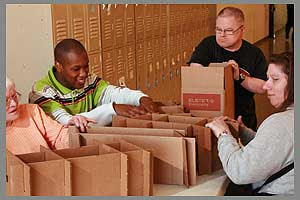Where will the nonprofit sector end up in the North Carolina tax reform debate?
 |
| Among its many services, Wake Enterprises provides an adult developmental vocation program focusing on teaching individuals work skills and appropriate interaction in the workplace. |
Special to Philanthropy Journal
Walter Weeks
Lawmakers in the North Carolina General Assembly are considering various tax reform proposals with provisions that would hurt charitable nonprofits. While modernizing tax law is praiseworthy as a concept, tax reform should not be done to the detriment of the charitable nonprofits that provide vital servces and important resources to North Carolinians. Our lawmakers must take into account in their deliberations how taking away tax exempts for nonprofits could have a variety of unintended consequences.
As of when I'm writing this, the Senate leadership's announced "Tax Fairness Act" is not yet formal legislation, but its elements have been enumerated. The plan will take away the sales tax exemption for all charitable nonprofits, by initially setting a cap on sales tax refunds and then reducing the cap to zero over three years. Additionally, the Senate leadership's plan would eliminate the deductibility of corporate charitable contributions and may treat individual contributions in the same manner. Further, new taxes are likely to be imposed on services offered by charitable nonprofits. The House reform effort, led by Representative David Lewis, is more reasonable for nonprofits, but nothing is set in stone and presumably anything could be brought up and altered in legislative negotiations.
 As Executive Director of Wake Enterprises, a 501(c)(3) organization providing life skills and job trainig to more than 250 people with intellectual and physical challenges, I know firsthand how eliminating the charitable nonprofit tax exemption will reduce critically needed community programs and services.
As Executive Director of Wake Enterprises, a 501(c)(3) organization providing life skills and job trainig to more than 250 people with intellectual and physical challenges, I know firsthand how eliminating the charitable nonprofit tax exemption will reduce critically needed community programs and services.In this economy, it can be worrisome to consider how most charitable nonprofits operate on thin budget margins. Eliminating nonprofits' tax exempt status could cut directly into the vital services they provide which may, in turn, lead to longer-term costs for state government and taxpayers.
North Carolina's charitable nonprofits are an important part of the social and economic fabric of the state. Our state lawmakers should appreciate how the charitable nonprofit sector is vital not only to citizens in need but also to the overall success of business and economic growth in North Carolina. Charitable nonprofits add value to North Carolinians and their communities across the state. By caring for the needy, supporting culture and the arts, providing spiritual guidance and supporting families from preschool to senior care, charitable nonprofits enrich our communities in ways that can attract new employers and grow our economy.
North Carolina's charitable nonprofit sector shares a common concern that nonprofits will lose important resources in the tax reform process - potentially hundreds of millions in total. I am working in cooperation with charitable nonprofits of various types and sizes from across the state to protect our tax-exempt status. Many of us are in close contact with our state legislators to seek updates and to talk about how important the tax exemption is for all charitable nonprofits.
North Carolina's charitable nonprofit organizations across the state share the view that the legislature would be wise to preserve our tax-exempt status to enable us to carry out our missions which are, after all, centered around the needs of all North Carolina citizens.
Walter T. Weeks Jr. is Executive Director of Wake Enterprises Inc., a private, nonprofit organization based in Raleigh whose mission is to assist people with disabilities to achieve their maximum level of independence.
Labels: economy, nonprofit sector, North Carolina General Assembly, resources, tax reform, tax reform debate, tax-exempt status, Wake Enterprises, Walter Weeks










